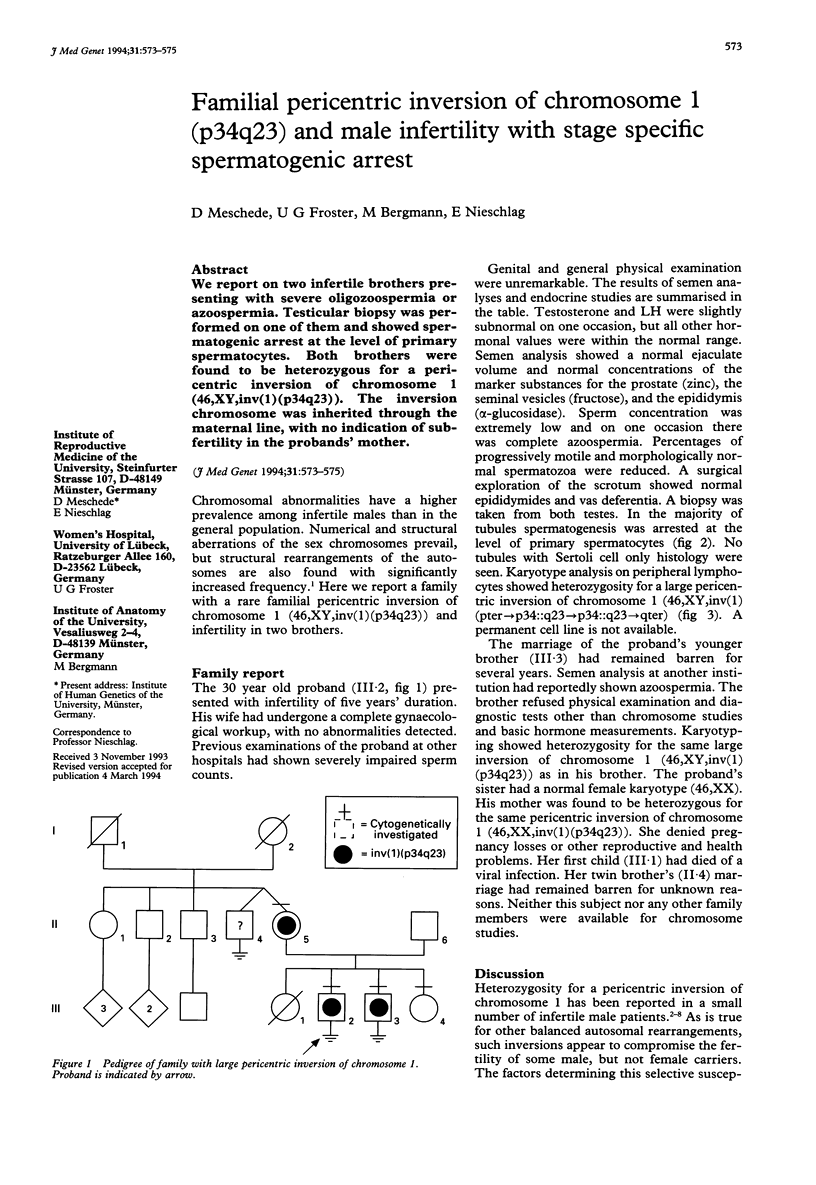Abstract
We report on two infertile brothers presenting with severe oligozoospermia or azoospermia. Testicular biopsy was performed on one of them and showed spermatogenic arrest at the level of primary spermatocytes. Both brothers were found to be heterozygous for a pericentric inversion of chromosome 1 (46,XY,inv(1)(p34q23)). The inversion chromosome was inherited through the maternal line, with no indication of subfertility in the probands' mother.
Full text
PDF


Images in this article
Selected References
These references are in PubMed. This may not be the complete list of references from this article.
- Barros A., Tavares M. C., Gomes M. P., Tavares M. P. Familial inv(1)(p36.3q12) associated with sterility. J Med Genet. 1986 Feb;23(1):90–91. doi: 10.1136/jmg.23.1.90-a. [DOI] [PMC free article] [PubMed] [Google Scholar]
- Batanian J., Hulten M. A. Electron microscopic investigations of synaptonemal complexes in an infertile human male carrier of a pericentric inversion inv(1)(p32q42). Regular loop formation but defective synapsis including a possible interchromosomal effect. Hum Genet. 1987 May;76(1):81–89. doi: 10.1007/BF00283055. [DOI] [PubMed] [Google Scholar]
- Bergmann M., Behre H. M., Nieschlag E. Serum FSH and testicular morphology in male infertility. Clin Endocrinol (Oxf) 1994 Jan;40(1):133–136. doi: 10.1111/j.1365-2265.1994.tb02455.x. [DOI] [PubMed] [Google Scholar]
- Chandley A. C., McBeath S., Speed R. M., Yorston L., Hargreave T. B. Pericentric inversion in human chromosome 1 and the risk for male sterility. J Med Genet. 1987 Jun;24(6):325–334. doi: 10.1136/jmg.24.6.325. [DOI] [PMC free article] [PubMed] [Google Scholar]
- Daniel A., Hook E. B., Wulf G. Risks of unbalanced progeny at amniocentesis to carriers of chromosome rearrangements: data from United States and Canadian laboratories. Am J Med Genet. 1989 May;33(1):14–53. doi: 10.1002/ajmg.1320330105. [DOI] [PubMed] [Google Scholar]
- De Braekeleer M., Dao T. N. Cytogenetic studies in male infertility: a review. Hum Reprod. 1991 Feb;6(2):245–250. [PubMed] [Google Scholar]
- Gabriel-Robez O., Ratomponirina C., Rumpler Y., Le Marec B., Luciani J. M., Guichaoua M. R. Synapsis and synaptic adjustment in an infertile human male heterozygous for a pericentric inversion in chromosome 1. Hum Genet. 1986 Feb;72(2):148–152. doi: 10.1007/BF00283934. [DOI] [PubMed] [Google Scholar]
- Guichaoua M. R., Delafontaine D., Taurelle R., Taillemite J. L., Morazzani M. R., Luciani J. M. Loop formation and synaptic adjustment in a human male heterozygous for two pericentric inversions. Chromosoma. 1986;93(4):313–320. doi: 10.1007/BF00327589. [DOI] [PubMed] [Google Scholar]
- Rivera H., Alvarez-Arratia M. C., Moller M., Díaz M., Cantú J. M. Familial inv(1) (p3500q21.3) associated with azoospermia. Hum Genet. 1984;66(2-3):165–167. doi: 10.1007/BF00286593. [DOI] [PubMed] [Google Scholar]
- Tóth A., Gaál M., Sára G., László J. Pericentric inversion of chromosome 1 in an azoospermic man. J Med Genet. 1982 Aug;19(4):303–305. [PMC free article] [PubMed] [Google Scholar]




